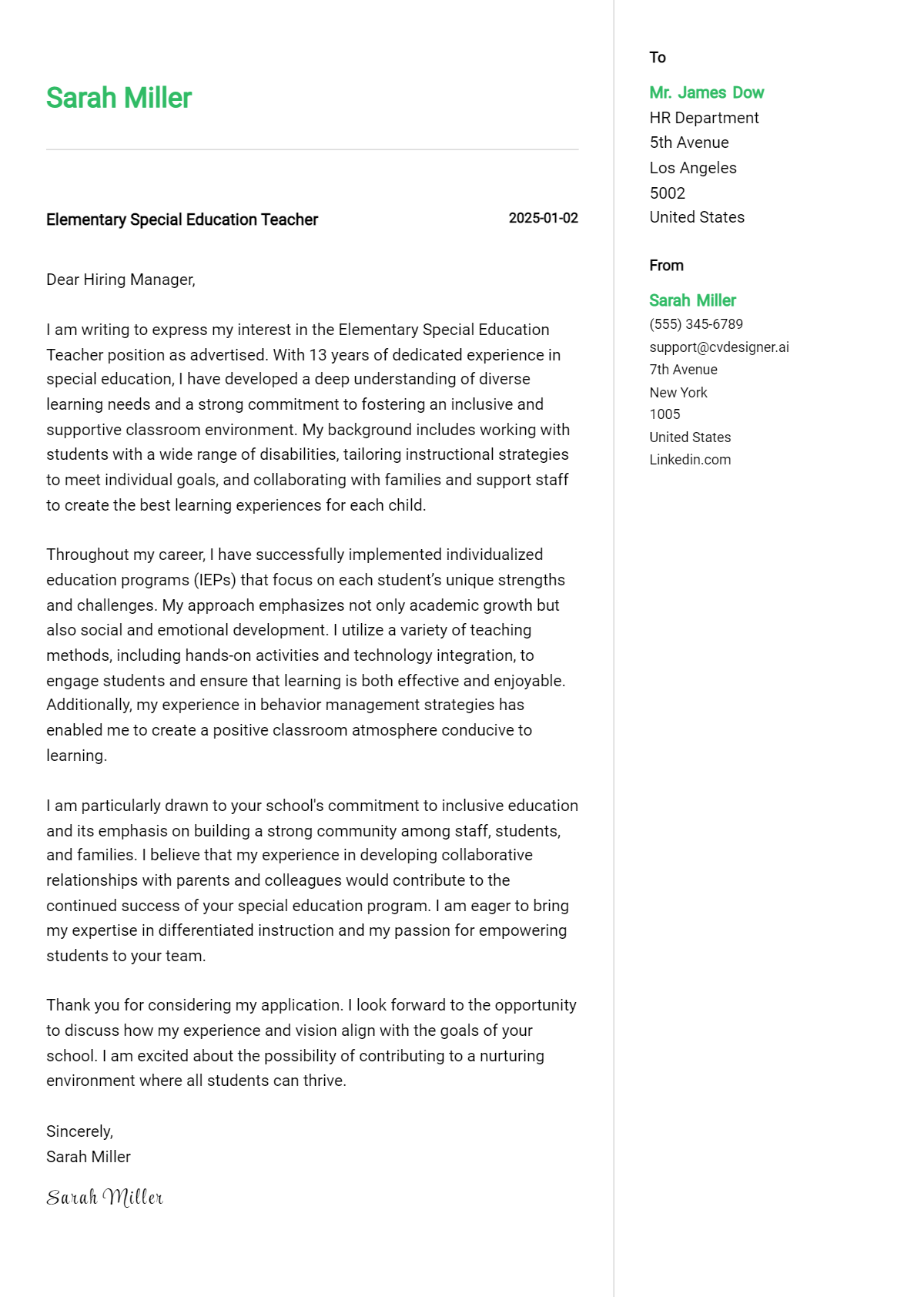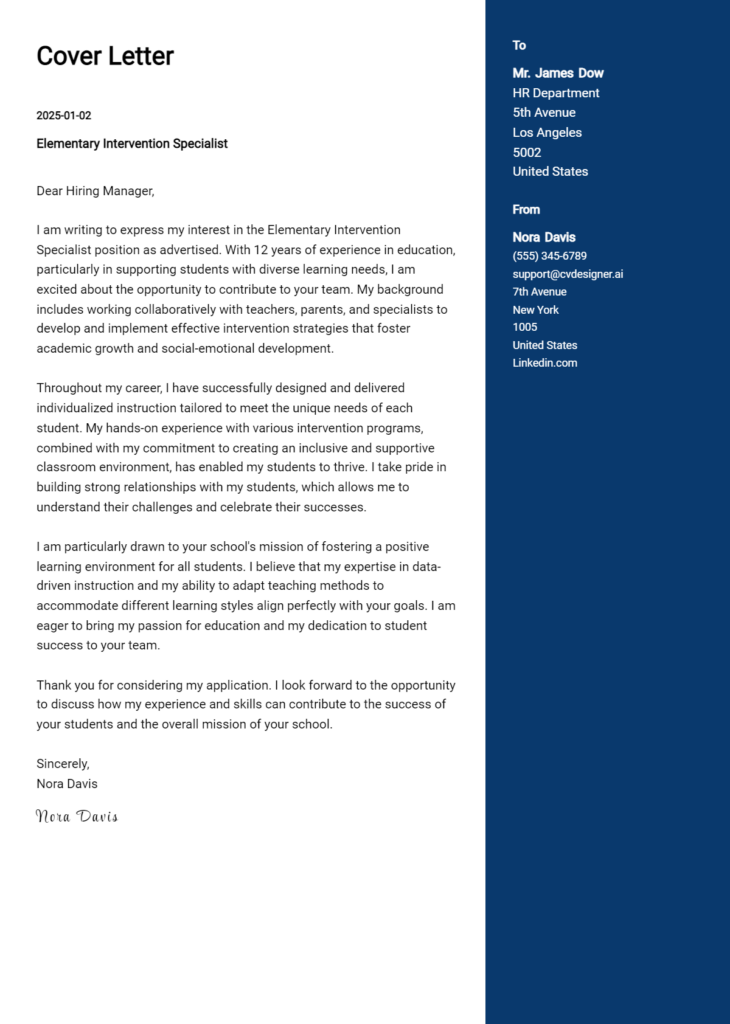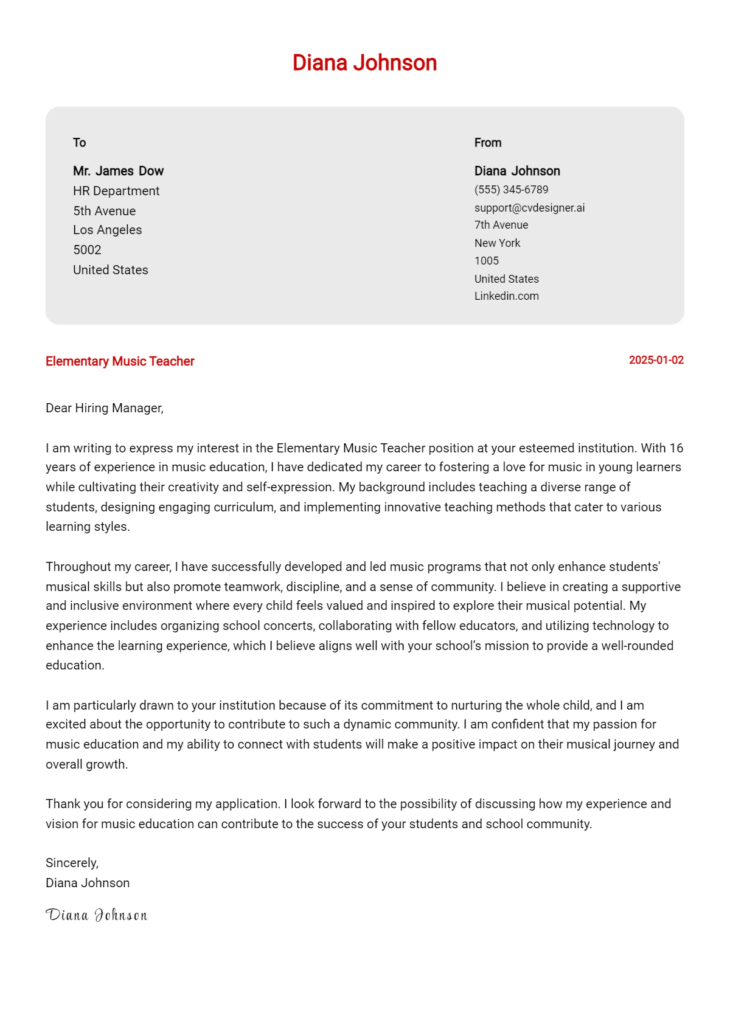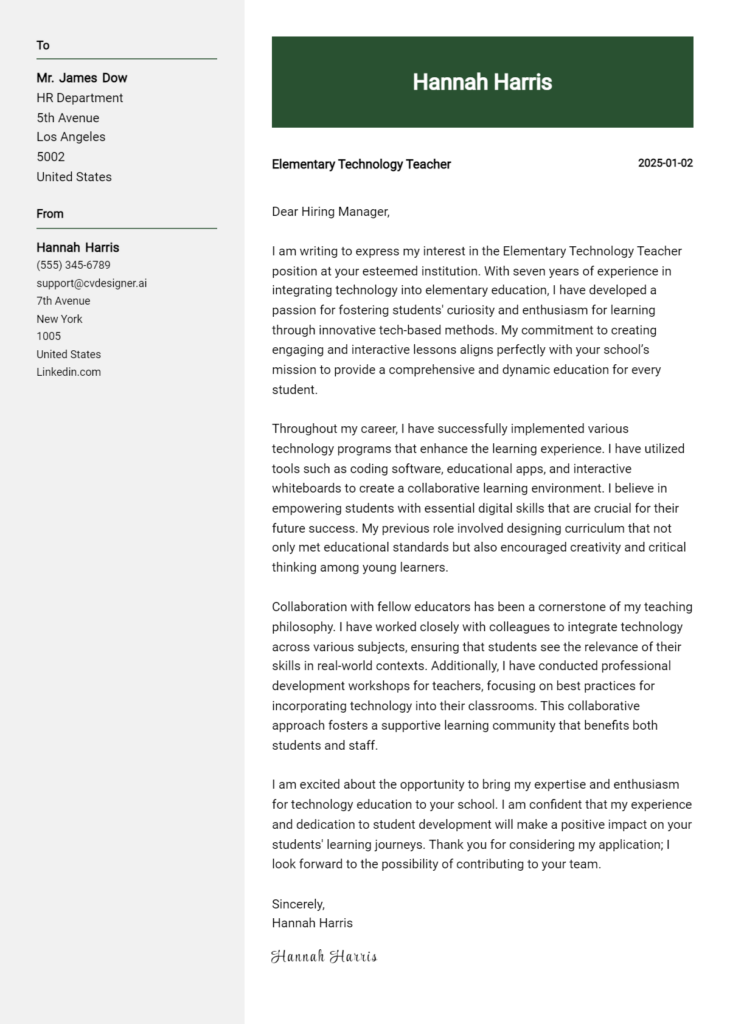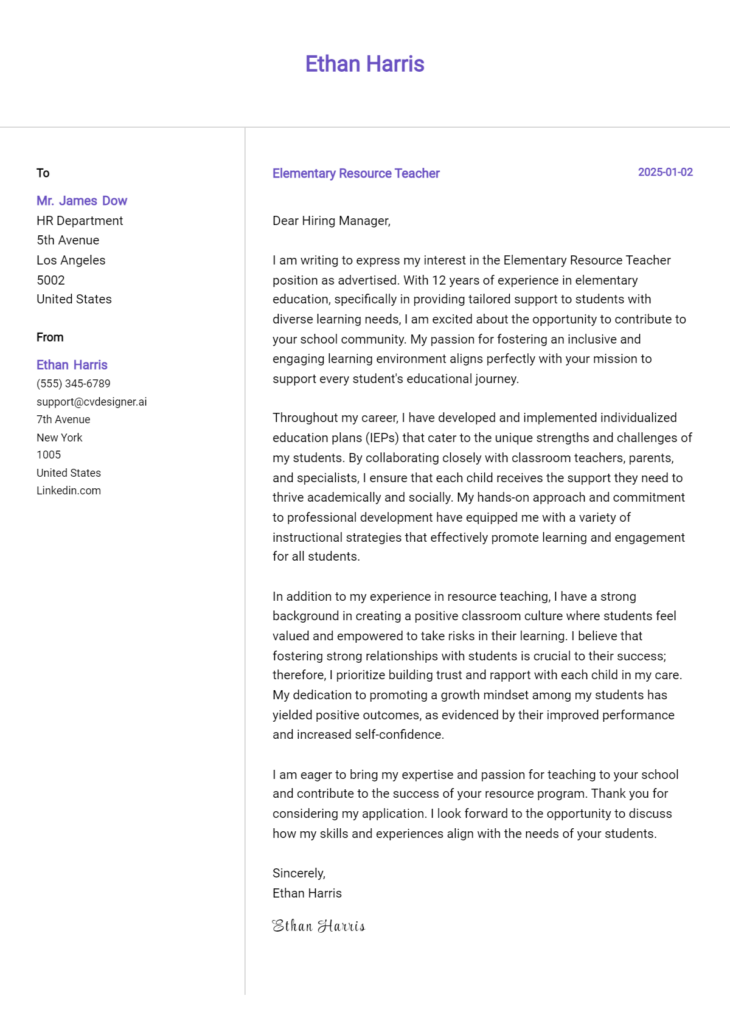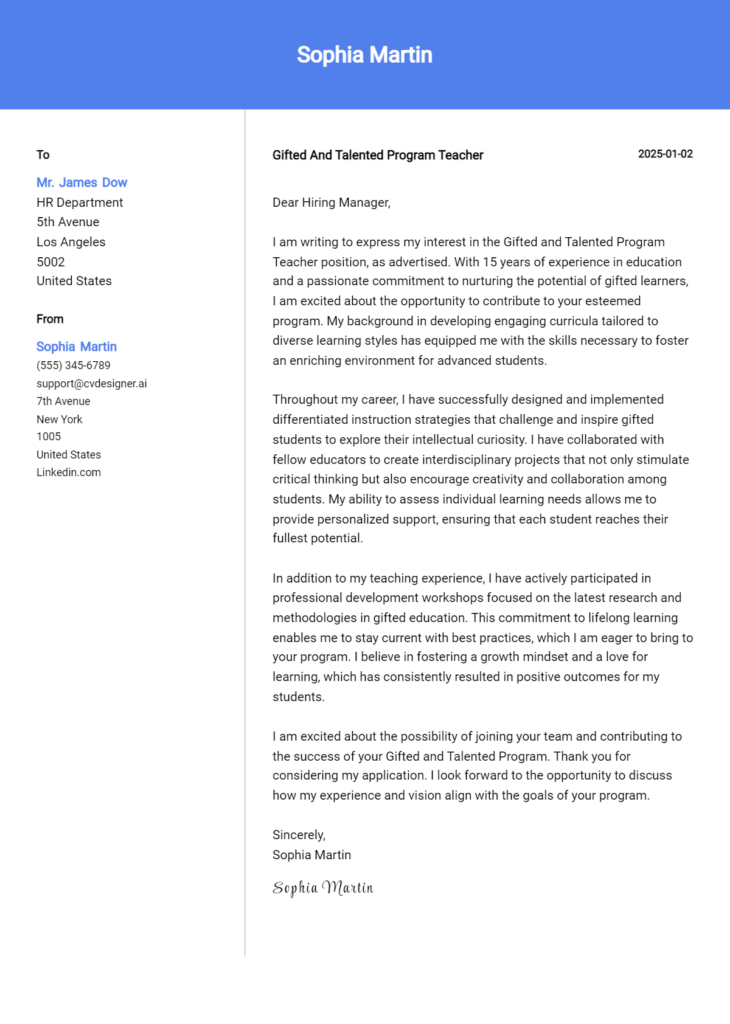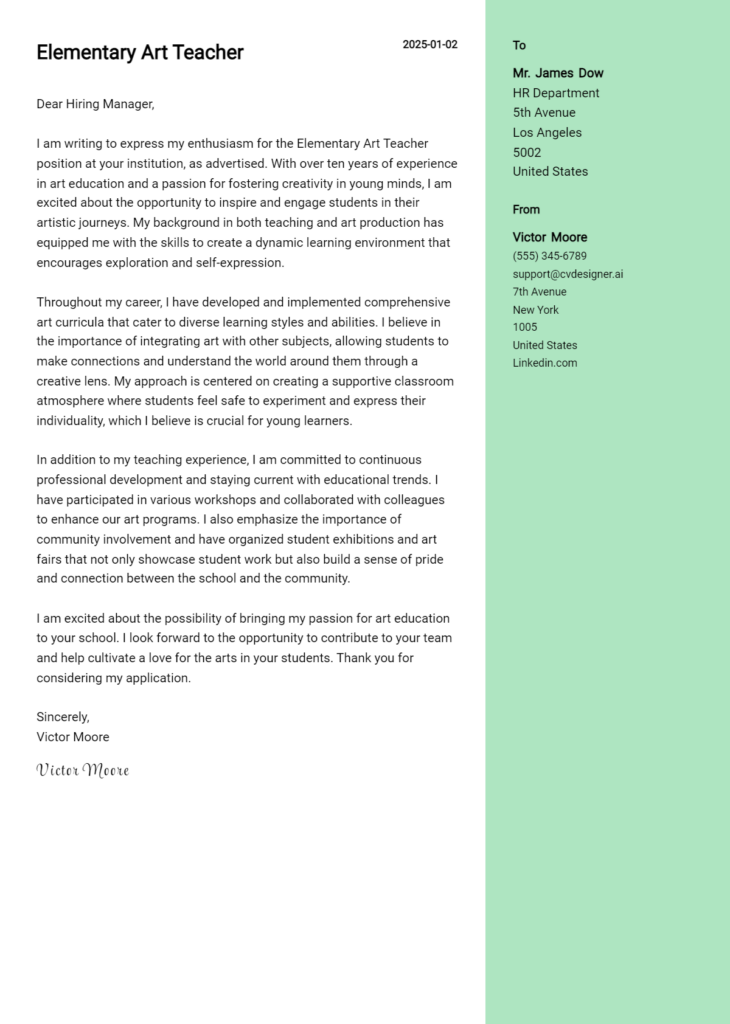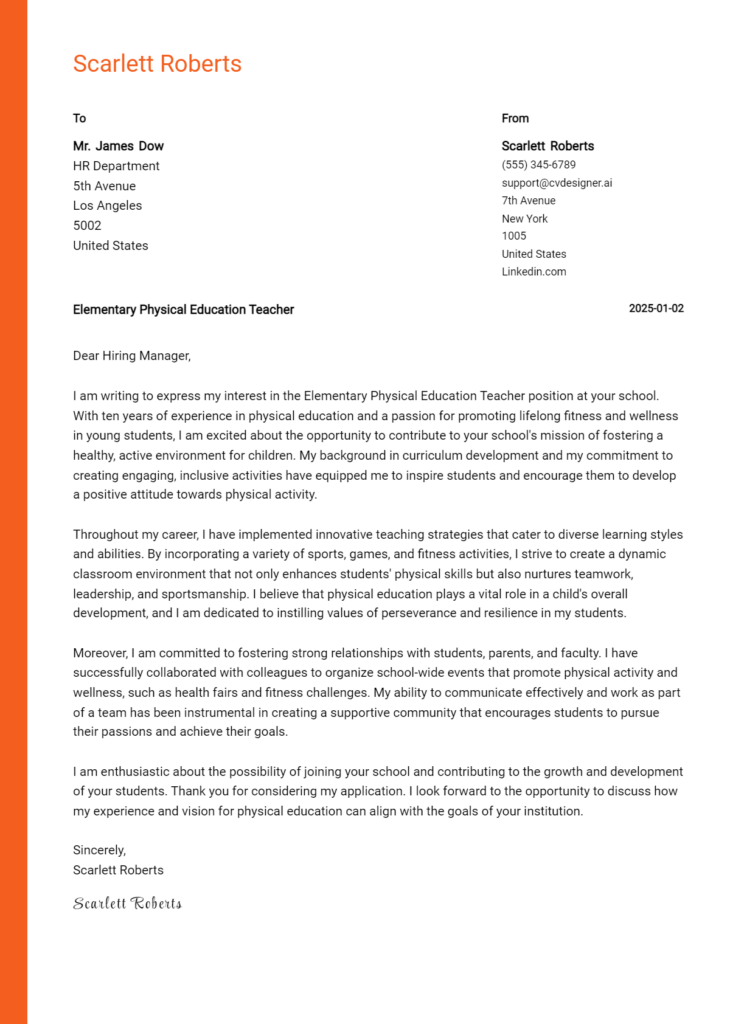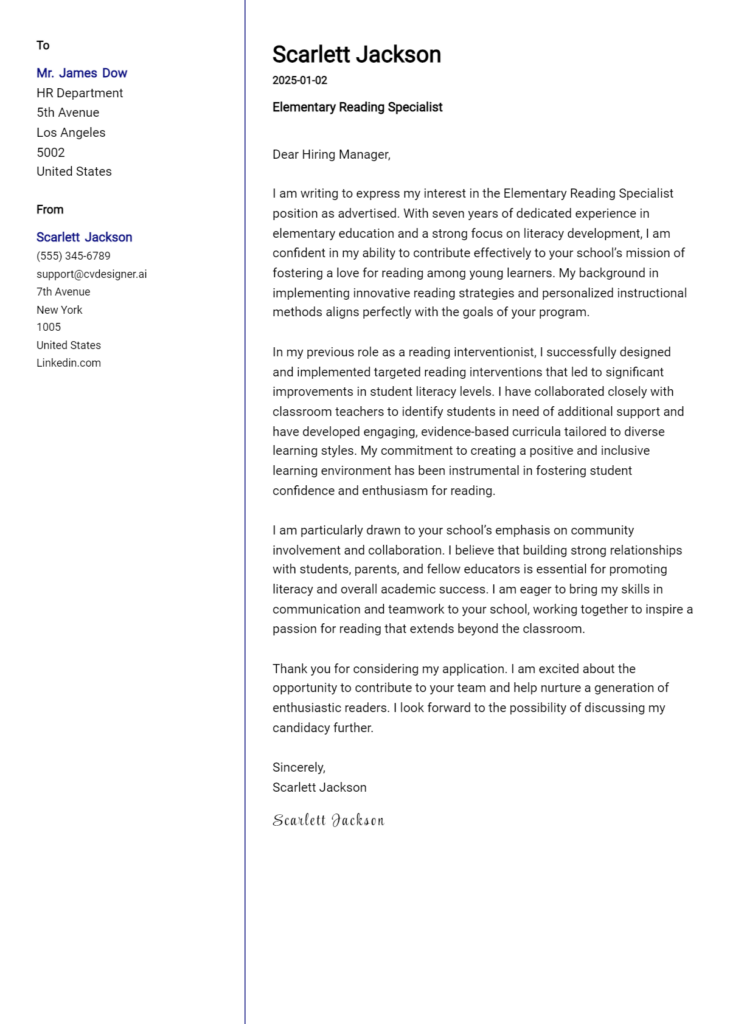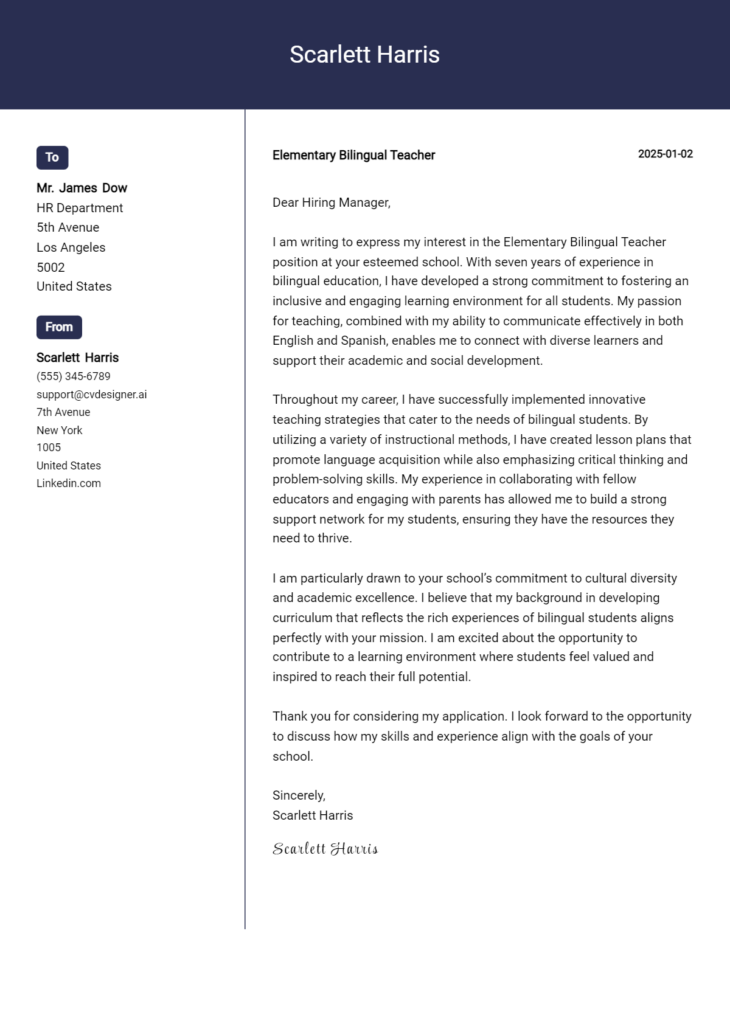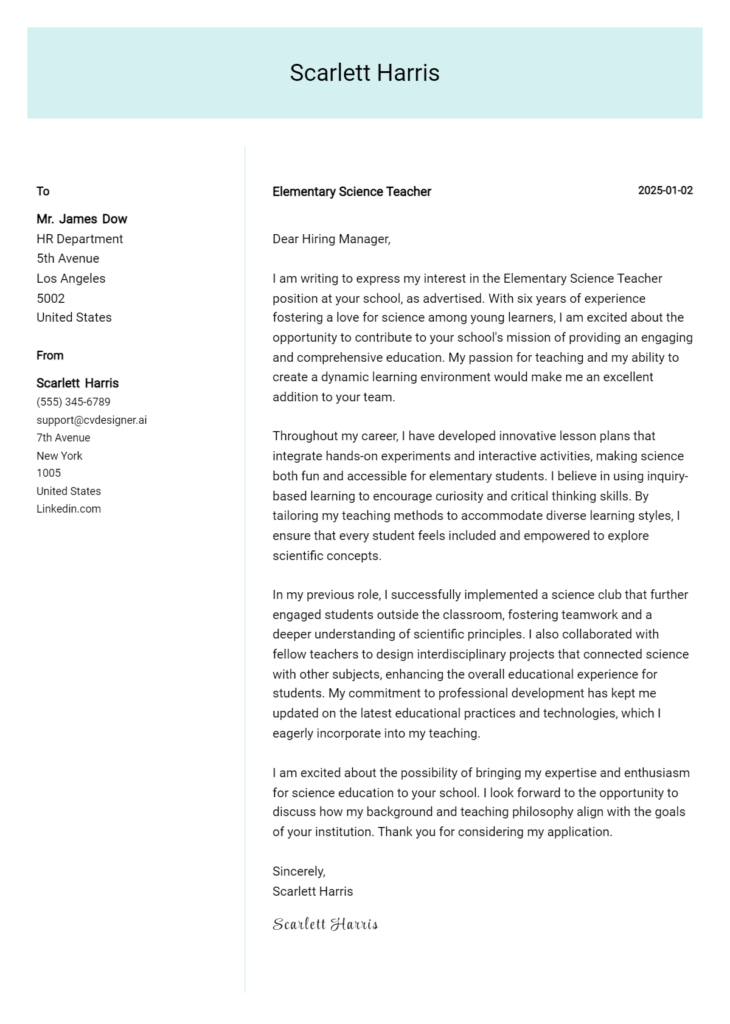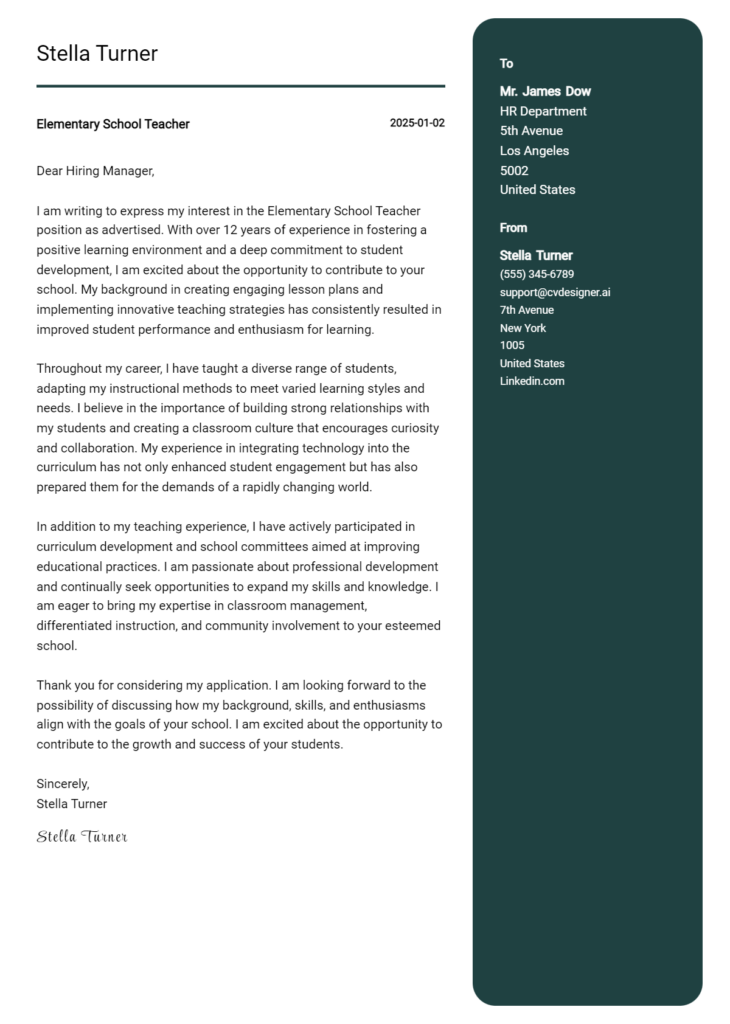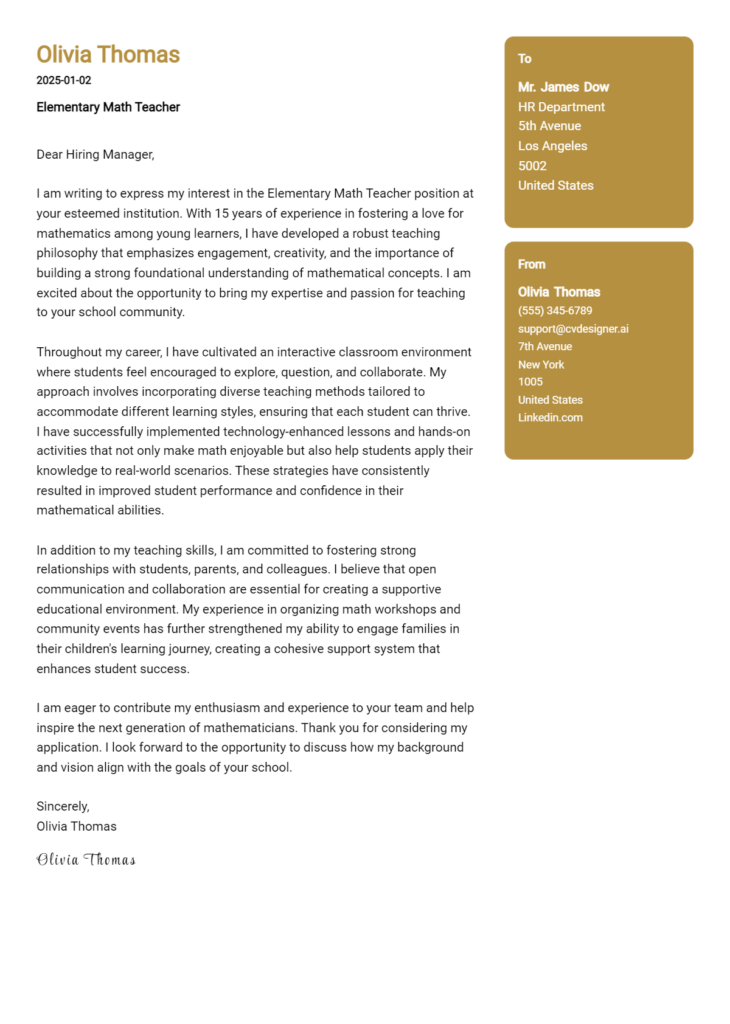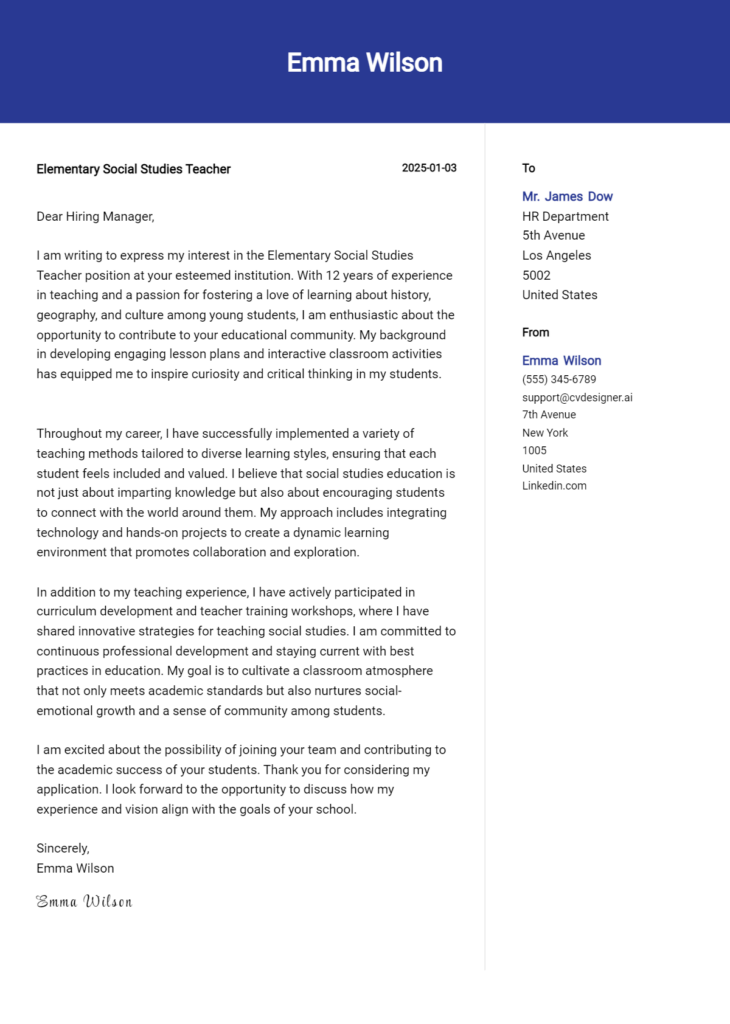Elementary Special Education Teacher Cover Letter Examples
Explore additional Elementary Special Education Teacher cover letter samples and guides and see what works for your level of experience or role.
How to Format an Elementary Special Education Teacher Cover Letter
Crafting a compelling cover letter is essential for an Elementary Special Education Teacher, as it serves as your first opportunity to showcase your passion for teaching and commitment to supporting diverse learners. The way you format your cover letter not only reflects your professionalism but also demonstrates your ability to communicate effectively—an invaluable skill in the field of education. A well-structured cover letter helps you stand out to hiring managers, highlighting both your qualifications and your unique approach to fostering an inclusive learning environment.
In this guide, we’ll explore how to structure your cover letter, providing specific insights and examples tailored for aspiring special education teachers.
We will focus on the key components of a professional cover letter, including:
Cover Letter Header
Cover Letter Greeting
Cover Letter Introduction
Cover Letter Body
Cover Letter Closing
Each section is crucial in emphasizing your qualifications and dedication to educating students with special needs. Let’s break down each part and discuss how to make your cover letter shine in the competitive field of special education.
Importance of the Cover Letter Header for an Elementary Special Education Teacher
The header of a cover letter plays a crucial role in establishing a professional first impression. It serves as the initial point of contact and sets the tone for the rest of the document. A well-structured header includes essential information such as the applicant's contact details, the date, and the recipient's information. Clarity and professionalism in this section are vital, as they reflect the applicant's attention to detail and respect for the hiring process. A strong header not only ensures that the letter can be easily identified and attributed to the correct person but also demonstrates the applicant's organizational skills—qualities that are particularly important in the field of education, especially when working with special needs students.
Strong Example
Jane Doe 123 Special Education Lane Educator City, ST 12345 (123) 456-7890 janedoe@email.com October 1, 2023 Mr. John Smith Principal ABC Elementary School 456 School Ave Educator City, ST 12345
Weak Example
October 1, 2023 Hi, I’m Jane. Here’s my application for the Special Ed Teacher job. Thanks!
The Importance of the Cover Letter Greeting for an Elementary Special Education Teacher
The greeting of your cover letter is crucial as it sets the tone for the rest of your application. A well-crafted greeting establishes professionalism and shows respect for the hiring manager or school administrator, while also providing a personal touch by addressing them directly. This initial connection can make a significant difference in how your application is received. To create a strong opening, it's essential to avoid generic greetings such as "To Whom It May Concern." Instead, take the time to research the hiring manager's name and use it in your greeting. This effort demonstrates your enthusiasm for the position and your commitment to the role of an Elementary Special Education Teacher.
Strong Greeting Example
Dear Ms. Smith,
Weak Greeting Example
To Whom It May Concern,
The Importance of a Strong Cover Letter Introduction for an Elementary Special Education Teacher
A well-crafted cover letter introduction is crucial for an Elementary Special Education Teacher as it sets the tone for the entire application. This opening paragraph should immediately capture the hiring manager's attention, showcasing the candidate's passion for special education while succinctly highlighting relevant skills and achievements. A strong introduction not only conveys genuine interest in the position but also establishes the candidate's qualifications, making them stand out in a competitive field. Below are examples of both strong and weak introductions to illustrate the impact of an effective opening.
Strong Example
Dear [Hiring Manager's Name], I am excited to apply for the Elementary Special Education Teacher position at [School Name], as I am deeply committed to fostering an inclusive learning environment where every child can thrive. With over five years of experience in special education and a Master's degree in Special Education, I have successfully developed individualized education plans (IEPs) that resulted in significant academic and social progress for my students. My passion for empowering students with diverse needs drives my dedication to create engaging, supportive, and tailored learning experiences for all learners.
Weak Example
To Whom It May Concern, I am interested in the job for an Elementary Special Education Teacher. I have worked with kids before and think I could do this job. I have some experience and have helped students in the past, but I am not sure what else to say. Please consider my application.
Cover Letter Body for Elementary Special Education Teacher
The body of a cover letter for an Elementary Special Education Teacher serves as a critical component in showcasing the candidate's unique skills, experiences, and the value they can bring to the educational institution. This section allows the candidate to highlight specific accomplishments and projects that demonstrate their ability to effectively support students with diverse learning needs. By providing concrete examples, the candidate can illustrate their teaching philosophy, commitment to inclusivity, and innovative approaches to education. Such details not only help to establish the candidate's qualifications but also convey their passion for fostering a positive and engaging learning environment for all students.
Strong Example
In my previous role at Sunshine Elementary, I successfully implemented a differentiated instruction program that catered to the varying needs of my students. This initiative included the development of individualized learning plans for each student, which resulted in a 30% increase in overall student engagement and a significant improvement in reading comprehension scores. Additionally, I collaborated with a team of specialists to organize a school-wide sensory integration fair, which provided essential resources and strategies for both teachers and parents to support children with sensory processing challenges. I am eager to bring my expertise in creating inclusive educational environments to your esteemed institution.
Weak Example
I have worked with kids for a long time and I think I would be a good fit for your school. I have helped students in my previous job, and I know how to work with special needs. I like to teach and I believe I can help your school.
Importance of the Cover Letter Closing for an Elementary Special Education Teacher
The closing paragraph of a cover letter is crucial as it provides a final opportunity to summarize qualifications, reaffirm interest in the position, and encourage the reader to take the next steps, such as reviewing the resume or scheduling an interview. A strong closing leaves a lasting impression, showcasing enthusiasm and professionalism, while a weak closing may fail to inspire action or convey genuine interest in the role.
Strong Example
In conclusion, I am eager to bring my passion for inclusive education and my extensive experience working with diverse learners to your team. I believe that my hands-on approach and commitment to fostering a supportive learning environment align perfectly with the values of your school. I look forward to the opportunity to discuss how I can contribute to the success of your students. Please feel free to review my resume, and I hope to schedule a time for an interview soon. Thank you for considering my application!
Weak Example
Thanks for reading my letter. I hope you like my resume. Let me know if you want to talk, I guess.
These tips will assist candidates in crafting an effective cover letter for the role of an Elementary Special Education Teacher. A well-written cover letter is crucial in demonstrating your technical skills, problem-solving abilities, and teamwork capabilities, as well as your commitment to continuous learning in the field. By effectively showcasing these attributes, you can stand out to potential employers and convey your passion for supporting students with special needs.
Tips for Writing an Effective Cover Letter
Highlight Relevant Technical Skills
Clearly outline your technical skills relevant to special education. Mention specific teaching strategies, tools, and methodologies you are proficient in, such as Individualized Education Programs (IEPs) and differentiated instruction. This not only demonstrates your qualifications but also shows that you are equipped to meet the diverse needs of your students.Demonstrate Problem-Solving Abilities
Provide examples of challenges you have faced in the classroom and how you addressed them. Discuss your approach to developing solutions for behavioral issues or learning difficulties, emphasizing your ability to adapt and implement effective strategies. This will illustrate your critical thinking skills and your commitment to student success.Showcase Knowledge of the Special Education Lifecycle (SDLC)
Familiarize yourself with the Special Education Lifecycle and reference it in your cover letter. Explain your role in the assessment, planning, implementation, and evaluation phases of special education services. This knowledge will reflect your comprehensive understanding of the processes involved in supporting students with disabilities.Emphasize Teamwork and Collaboration
Collaboration is essential in special education. Mention your experience working with a multidisciplinary team, including other educators, therapists, and parents. Share specific instances where teamwork led to improved outcomes for students, highlighting your ability to communicate effectively and foster positive relationships.Convey a Passion for Continuous Learning
Express your commitment to professional development and lifelong learning. Discuss any additional certifications, workshops, or courses you have pursued to enhance your skills in special education. This not only reflects your dedication to personal growth but also assures employers that you are prepared to keep up with evolving practices in the field.
For more assistance with your cover letter, consider exploring a variety of cover letter templates or use a cover letter builder to create a polished and professional document. These resources can help you structure your letter effectively while ensuring it resonates with potential employers.
Common Mistakes to Avoid in a Elementary Special Education Teacher Cover Letter
Crafting a compelling cover letter is essential for standing out in the competitive field of elementary special education. Avoiding common mistakes can significantly enhance your chances of making a positive impression on hiring committees. Here are some pitfalls to watch out for and tips on how to avoid them:
Generic Language: Using a one-size-fits-all approach can make your letter feel impersonal. Tailor your letter to the specific school and role by incorporating the school's mission and values.
Neglecting Format: An improperly formatted cover letter can detract from your message. Follow a clear cover letter format to ensure professionalism and readability.
Lack of Specific Examples: Failing to provide concrete examples of your experience or achievements can weaken your case. Highlight specific instances where you successfully supported students with special needs.
Overly Lengthy: A cover letter that is too long may lose the reader's interest. Aim for a concise letter that highlights your qualifications in a few impactful paragraphs.
Ignoring the Job Description: Not aligning your skills with the job requirements can hurt your candidacy. Carefully read the job description and incorporate relevant keywords and duties into your letter.
Spelling and Grammar Errors: Typos can create a negative impression. Always proofread your letter and consider asking a colleague to review it for additional perspectives.
Lack of Enthusiasm: A dull tone can make you seem uninterested in the position. Infuse your letter with genuine enthusiasm for working with special education students and the impact you hope to make.
For additional guidance, you can explore various cover letter examples to inspire your writing. Avoiding these common mistakes will help you create a strong foundation for a successful application.
Cover Letter FAQs for Elementary Special Education Teacher
What should I include in my cover letter for a Special Education teaching position?
When applying for an Elementary Special Education Teacher position, your cover letter should highlight your qualifications, teaching philosophy, and relevant experiences. Begin with a strong introduction that captures your passion for special education. Discuss your educational background, certifications, and any specialized training you've received. Make sure to mention specific strategies or approaches you've successfully implemented in the classroom, such as individualized education programs (IEPs) or behavior management techniques. Finally, express your commitment to fostering an inclusive learning environment where all students can thrive. Personalizing your letter to the school’s mission and values can also make a strong impression.
How long should my cover letter be?
Your cover letter should ideally be one page long, consisting of three to four paragraphs. This length allows you to concisely convey your qualifications and enthusiasm without overwhelming the reader. Aim for about 250-400 words in total. Start with a brief introduction, followed by a paragraph detailing your relevant experience and skills. If applicable, include a section on your teaching philosophy or specific strategies you utilize in special education. Conclude with a strong closing statement that reiterates your interest in the position and invites the reader to contact you for further discussion.
How can I make my cover letter stand out?
To make your cover letter stand out, focus on showcasing your unique qualifications and experiences that relate specifically to special education. Use compelling anecdotes that demonstrate your ability to connect with students and address their diverse needs. Incorporate specific examples of successful interventions or adaptations you've made in your teaching practice. Additionally, research the school and mention any programs or initiatives that resonate with your approach to education. Using a professional yet personable tone can also help convey your passion for teaching and commitment to student success.
Should I include references in my cover letter?
It’s generally not necessary to include references in your cover letter. Instead, focus on showcasing your qualifications and experiences that align with the job description. References are typically provided in a separate document or during the interview process. However, you can mention that references are available upon request at the end of your letter. This demonstrates your preparedness and willingness to provide further support for your candidacy. Instead, use your cover letter to highlight your teaching philosophy, specific skills, and any unique contributions you can bring to the school’s special education program.
Build your Cover Letter in minutes
Use an AI-powered cover letter builder and have your letter done in 5 minutes. Just select your template and our software will guide you through the process.

